Mathematics teacher education and the flexible use of technologies in digital age
Advantages and disadvantages of the use of digital technologies (DT) in mathematics lessons are worldwide
dissussed controversially. Many empirical studies show the benefit
of the use of DT in classrooms. However, despite of inspiring
results, classroom suggestions, lesson plans and research reports,
the use of DT has not succeeded, as many had expected during the
last decades. One reason is or might be that we have not been able
to convince teachers and lecturers at universities of the benefit of
DT in the classrooms in a sufficient way. However, to show this
benefit has to be a crucial goal in teacher education because it will
be a condition for preparing teachers for industrial revolution 4.0.
In the following we suggest a competence model, which classifies
– for a special content (like function, equation or derivative) –
the relation between levels of understanding (of the concept),
representations of DT and different kind of classroom activities.
The flesxible use of digital technologies will be seen in relation
to this competence model, results of empirical investigations will
be intergrated and examples of the use of technologies in the upcoming digital age will be given.

Trang 1
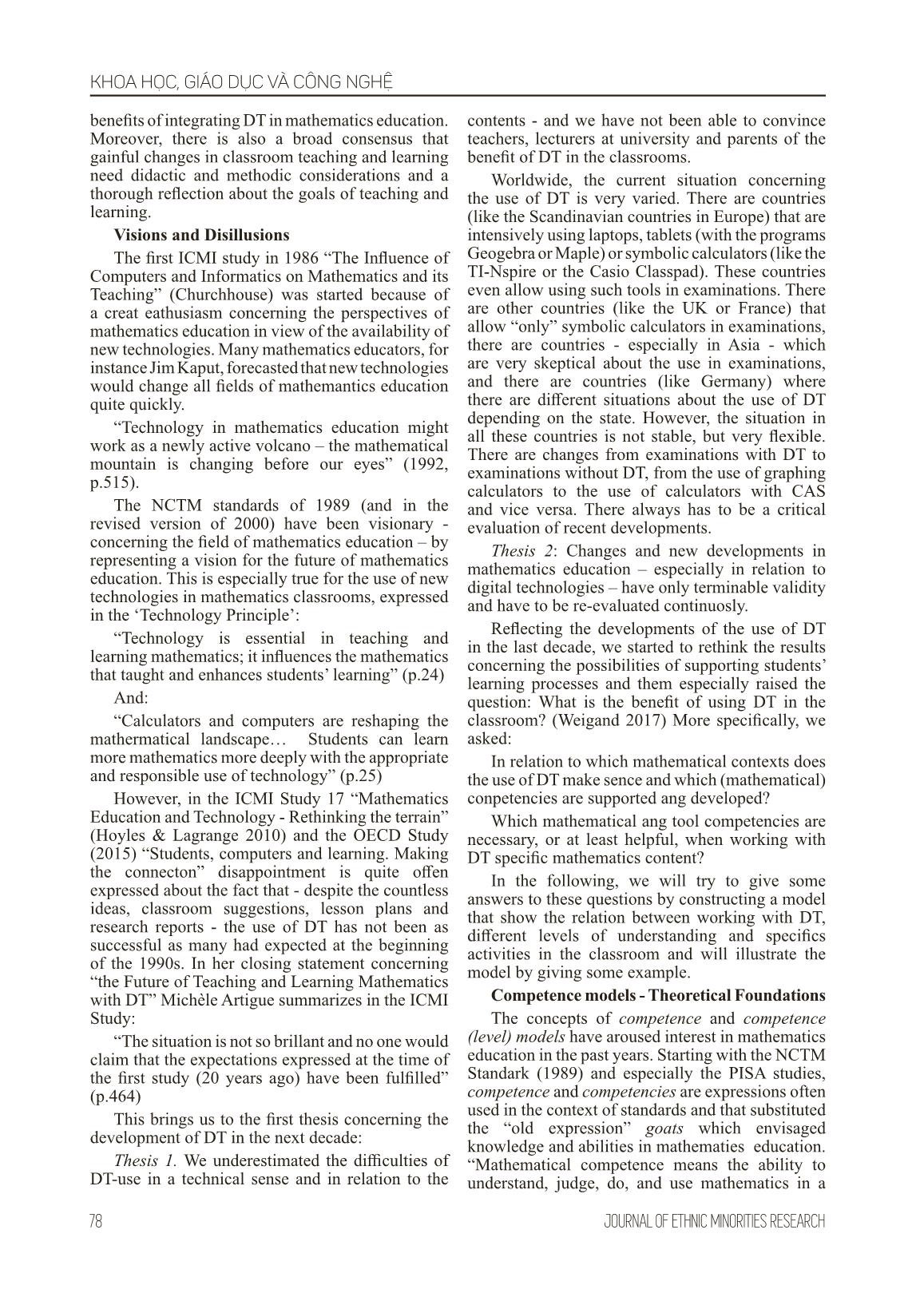
Trang 2
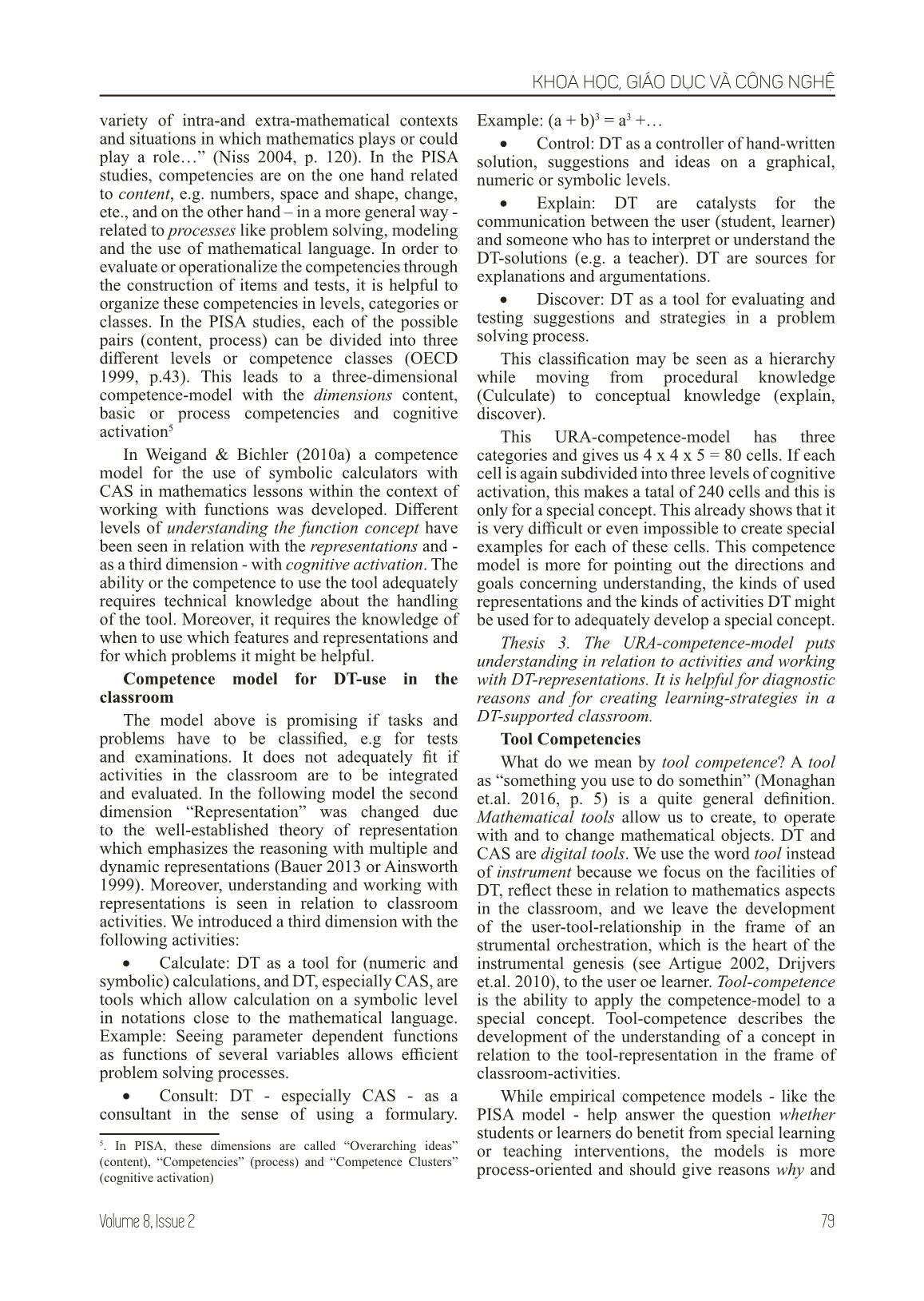
Trang 3
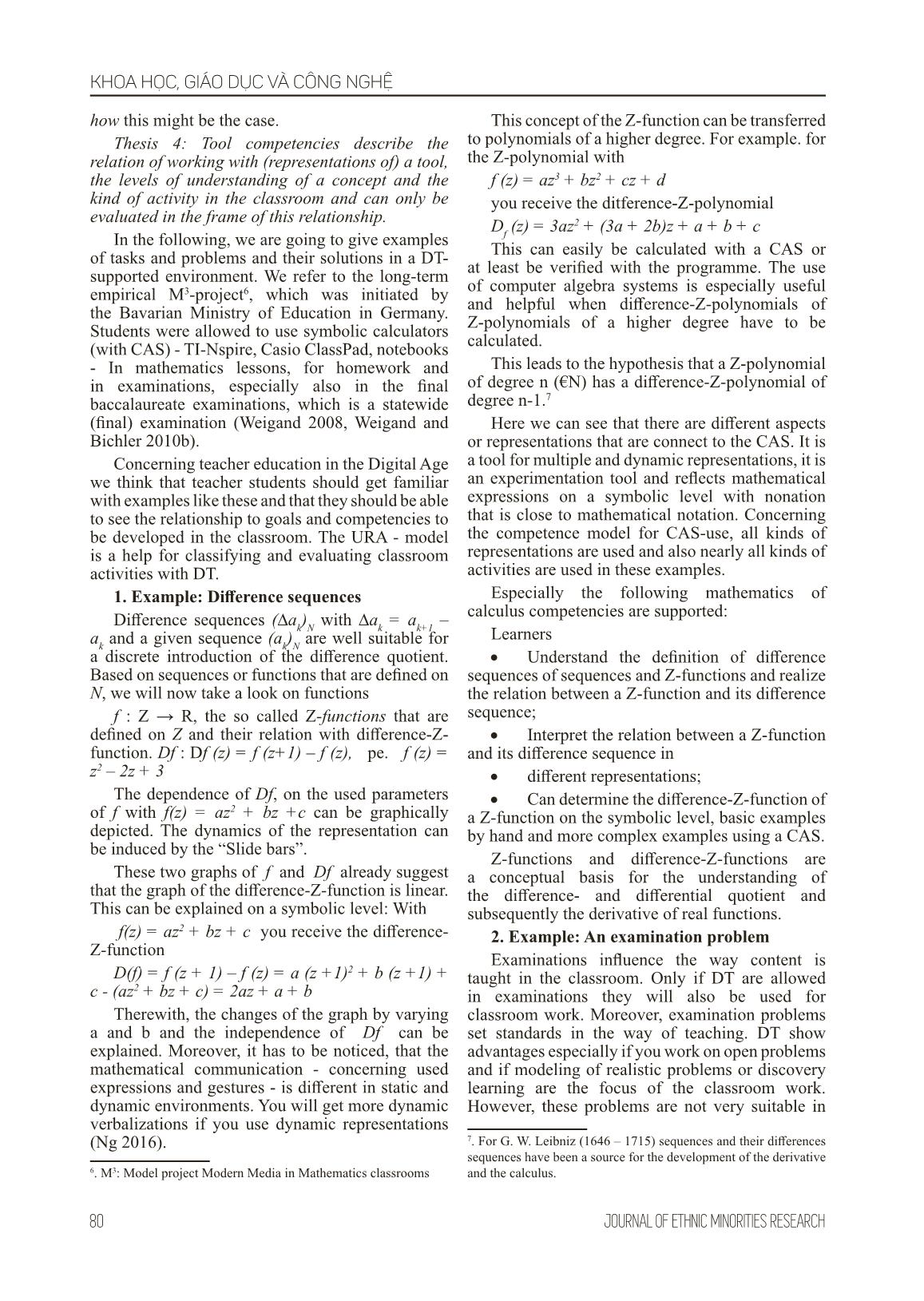
Trang 4
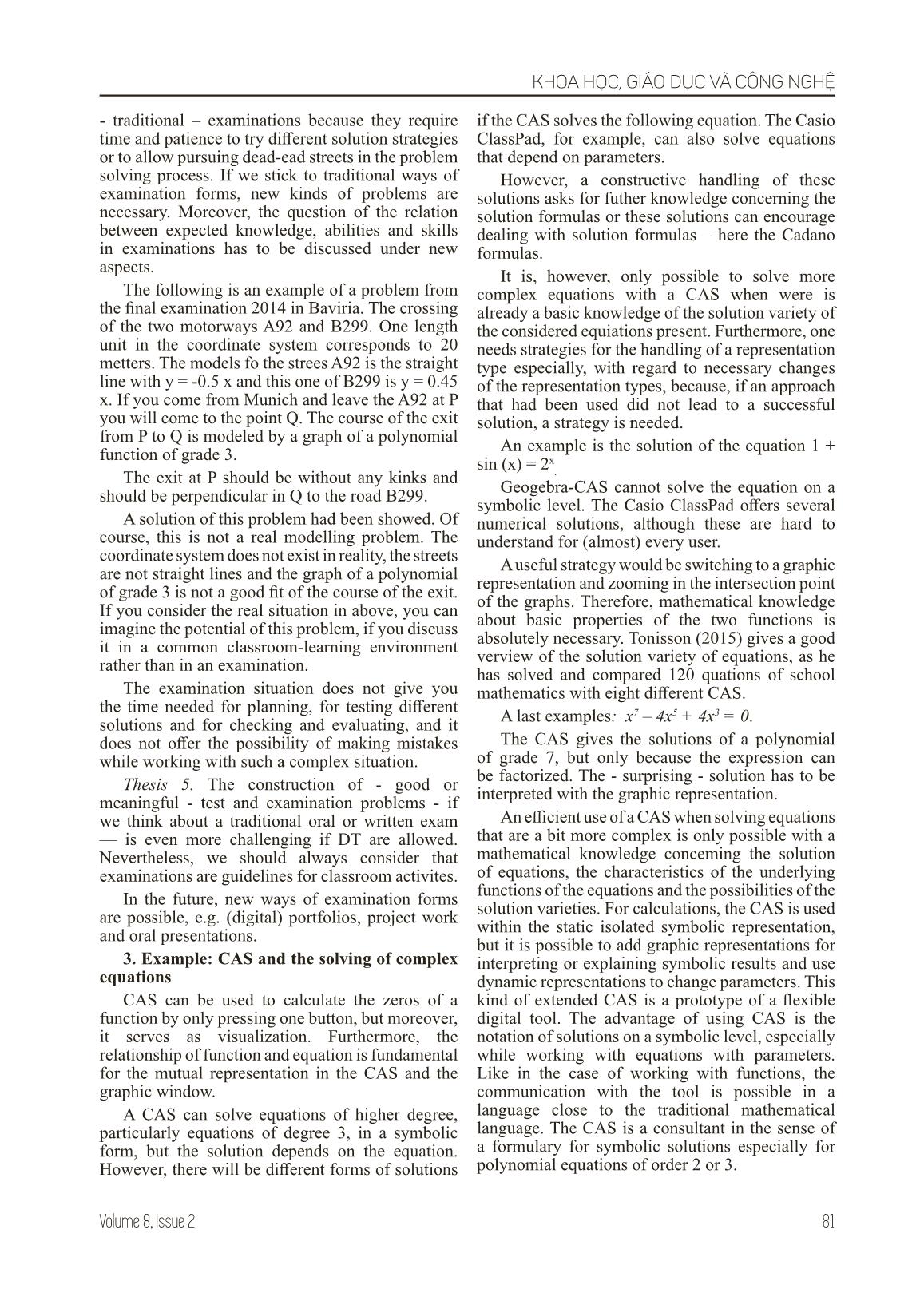
Trang 5
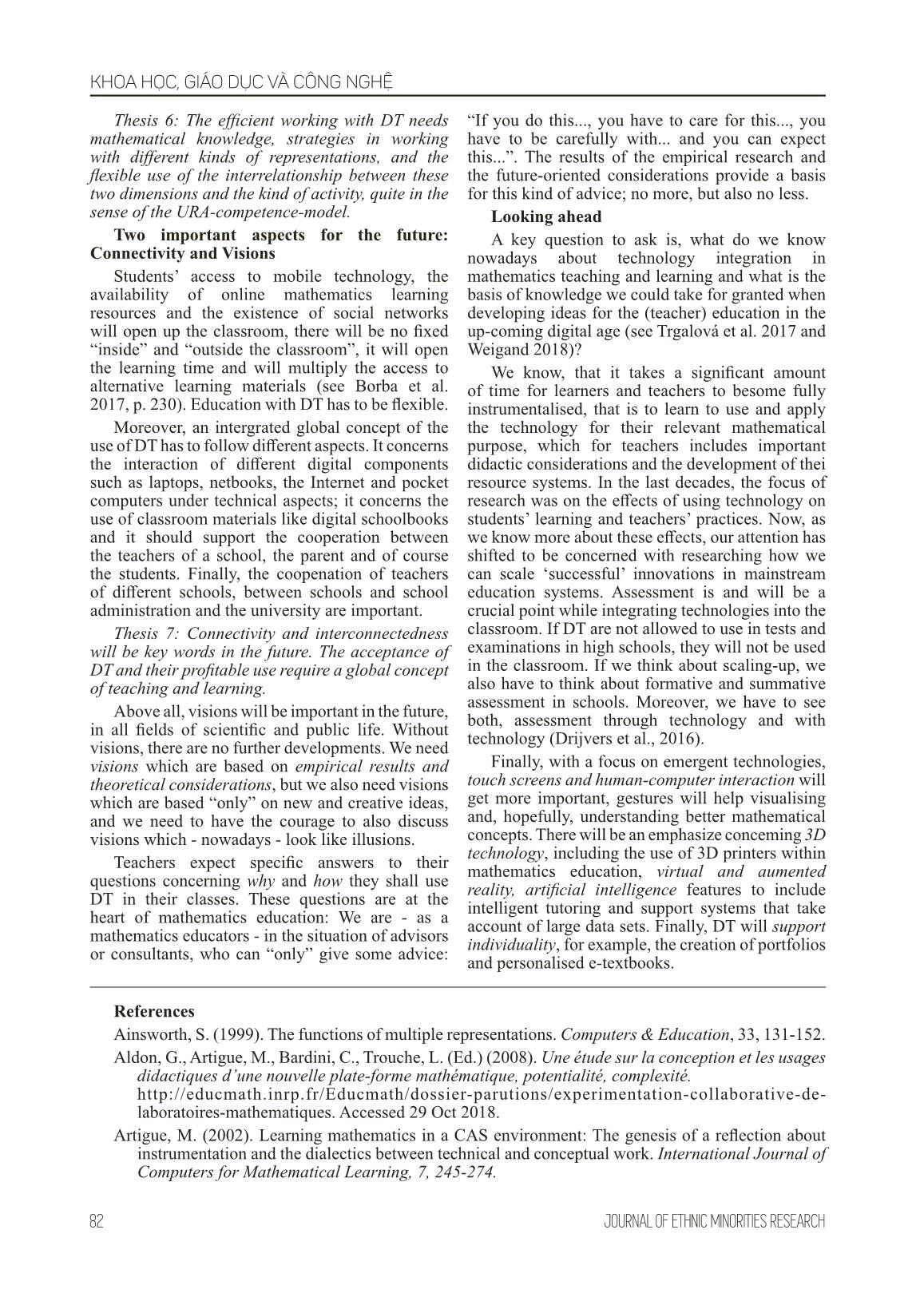
Trang 6

Trang 7
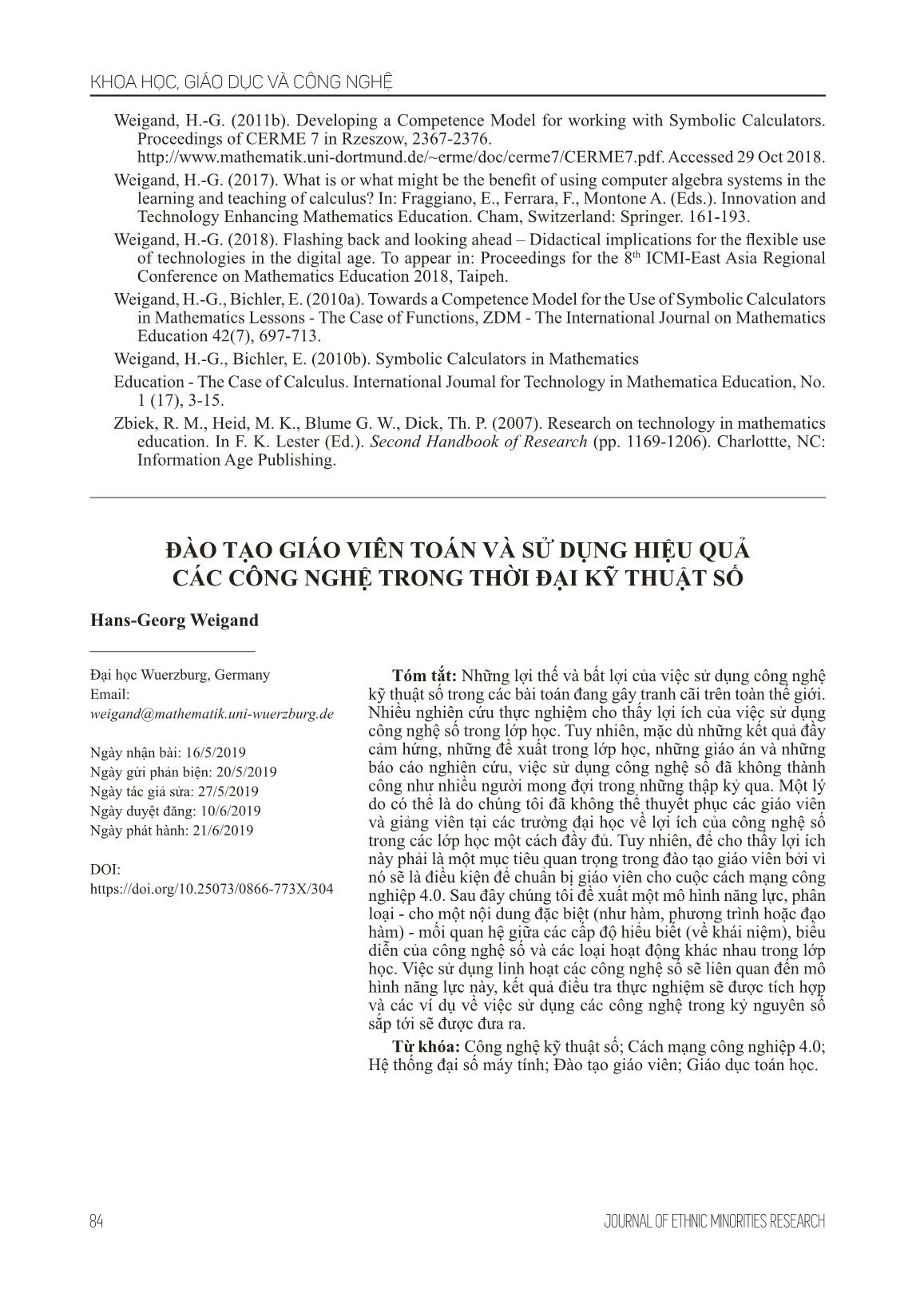
Trang 8
Tóm tắt nội dung tài liệu: Mathematics teacher education and the flexible use of technologies in digital age
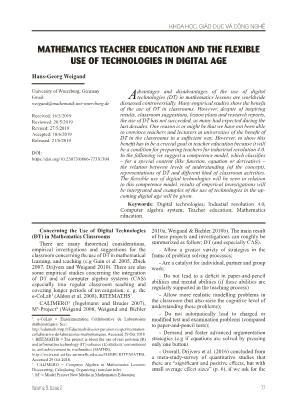
equations with a CAS when were is already a basic knowledge of the solution variety of the considered equiations present. Furthermore, one needs strategies for the handling of a representation type especially, with regard to necessary changes of the representation types, because, if an approach that had been used did not lead to a successful solution, a strategy is needed. An example is the solution of the equation 1 + sin (x) = 2x . Geogebra-CAS cannot solve the equation on a symbolic level. The Casio ClassPad offers several numerical solutions, although these are hard to understand for (almost) every user. A useful strategy would be switching to a graphic representation and zooming in the intersection point of the graphs. Therefore, mathematical knowledge about basic properties of the two functions is absolutely necessary. Tonisson (2015) gives a good verview of the solution variety of equations, as he has solved and compared 120 quations of school mathematics with eight different CAS. A last examples: x7 – 4x5 + 4x3 = 0. The CAS gives the solutions of a polynomial of grade 7, but only because the expression can be factorized. The - surprising - solution has to be interpreted with the graphic representation. An efficient use of a CAS when solving equations that are a bit more complex is only possible with a mathematical knowledge conceming the solution of equations, the characteristics of the underlying functions of the equations and the possibilities of the solution varieties. For calculations, the CAS is used within the static isolated symbolic representation, but it is possible to add graphic representations for interpreting or explaining symbolic results and use dynamic representations to change parameters. This kind of extended CAS is a prototype of a flexible digital tool. The advantage of using CAS is the notation of solutions on a symbolic level, especially while working with equations with parameters. Like in the case of working with functions, the communication with the tool is possible in a language close to the traditional mathematical language. The CAS is a consultant in the sense of a formulary for symbolic solutions especially for polynomial equations of order 2 or 3. KHOA HỌC, GIÁO DỤC VÀ CÔNG NGHỆ 82 JOURNAL OF ETHNIC MINORITIES RESEARCH Thesis 6: The efficient working with DT needs mathematical knowledge, strategies in working with different kinds of representations, and the flexible use of the interrelationship between these two dimensions and the kind of activity, quite in the sense of the URA-competence-model. Two important aspects for the future: Connectivity and Visions Students’ access to mobile technology, the availability of online mathematics learning resources and the existence of social networks will open up the classroom, there will be no fixed “inside” and “outside the classroom”, it will open the learning time and will multiply the access to alternative learning materials (see Borba et al. 2017, p. 230). Education with DT has to be flexible. Moreover, an intergrated global concept of the use of DT has to follow different aspects. It concerns the interaction of different digital components such as laptops, netbooks, the Internet and pocket computers under technical aspects; it concerns the use of classroom materials like digital schoolbooks and it should support the cooperation between the teachers of a school, the parent and of course the students. Finally, the coopenation of teachers of different schools, between schools and school administration and the university are important. Thesis 7: Connectivity and interconnectedness will be key words in the future. The acceptance of DT and their profitable use require a global concept of teaching and learning. Above all, visions will be important in the future, in all fields of scientific and public life. Without visions, there are no further developments. We need visions which are based on empirical results and theoretical considerations, but we also need visions which are based “only” on new and creative ideas, and we need to have the courage to also discuss visions which - nowadays - look like illusions. Teachers expect specific answers to their questions concerning why and how they shall use DT in their classes. These questions are at the heart of mathematics education: We are - as a mathematics educators - in the situation of advisors or consultants, who can “only” give some advice: “If you do this..., you have to care for this..., you have to be carefully with... and you can expect this...”. The results of the empirical research and the future-oriented considerations provide a basis for this kind of advice; no more, but also no less. Looking ahead A key question to ask is, what do we know nowadays about technology integration in mathematics teaching and learning and what is the basis of knowledge we could take for granted when developing ideas for the (teacher) education in the up-coming digital age (see Trgalová et al. 2017 and Weigand 2018)? We know, that it takes a significant amount of time for learners and teachers to besome fully instrumentalised, that is to learn to use and apply the technology for their relevant mathematical purpose, which for teachers includes important didactic considerations and the development of thei resource systems. In the last decades, the focus of research was on the effects of using technology on students’ learning and teachers’ practices. Now, as we know more about these effects, our attention has shifted to be concerned with researching how we can scale ‘successful’ innovations in mainstream education systems. Assessment is and will be a crucial point while integrating technologies into the classroom. If DT are not allowed to use in tests and examinations in high schools, they will not be used in the classroom. If we think about scaling-up, we also have to think about formative and summative assessment in schools. Moreover, we have to see both, assessment through technology and with technology (Drijvers et al., 2016). Finally, with a focus on emergent technologies, touch screens and human-computer interaction will get more important, gestures will help visualising and, hopefully, understanding better mathematical concepts. There will be an emphasize conceming 3D technology, including the use of 3D printers within mathematics education, virtual and aumented reality, artificial intelligence features to include intelligent tutoring and support systems that take account of large data sets. Finally, DT will support individuality, for example, the creation of portfolios and personalised e-textbooks. References Ainsworth, S. (1999). The functions of multiple representations. Computers & Education, 33, 131-152. Aldon, G., Artigue, M., Bardini, C., Trouche, L. (Ed.) (2008). Une étude sur la conception et les usages didactiques d’une nouvelle plate-forme mathématique, potentialité, complexité. laboratoires-mathematiques. Accessed 29 Oct 2018. Artigue, M. (2002). Learning mathematics in a CAS environment: The genesis of a reflection about instrumentation and the dialectics between technical and conceptual work. International Journal of Computers for Mathematical Learning, 7, 245-274. KHOA HỌC, GIÁO DỤC VÀ CÔNG NGHỆ 83Volume 8, Issue 2 Bauer A. (2013). Reasoning with multiple and dynamic representations. In: Faggione, E., Montone, A.: Proceedings of the ICIMT 11, Bari. 327-329 Dm.uniba.it/ictmt11/download/ ICTMT11_Proceedings.pdf. Accessed 29 Oct 2018. Borba, M C., Askar, P., Engelbrecht, J., Gadanidis, G., Llinares S., Aguilar, M.S. (2017): Digital Technology in Mathematics Education: Research over the Last Decade. In: Kaiser, G. (Ed.). Proceedings of the 13th International Congress on Mathematical Education. Mongraphs. Cham, Switzerland: Springer, 221-233. Churchhouse, R. F. (Ed.) (1986). The Influence of Computers and Informatics on Mathematics and its Teaching. ICMI Study Series. Cambridge: University Press. Drijvers, P. et.al. (2010). Integrating technology into mathematics education: Theoretical perspectives. In: Hoyles, C., Lagrange, B. (eds.) Mathematics education and technology-rethinking the terrain. The 17th ICMI study. Dordrecht: Springer: 89-132. Drijvers, P., Monoghan, J., Thomas, M., Trouche, L. (2016). Use of Technology in Secondary Mathematics - Final Report for the International Baccalaureate. finalreport. pdf. Accessed 29 Oct 2018. Drijvers, P., Weigand, H.-G. (Hrsg.) (2010). Handheld technology in the mathematics classroom - theory and practice, ZDM - The International Journal on Mathematics Education, 7. Drijvers, P., Ball, L., Barzel, B., Heid, M. K., Cao, Y., & Maschietto, M. (2016). Uses of Technology in Lower Secondary Mathematics Education: A concise topical survey. In ICME-13 Topical Surveys (pp. 1-34). New York, NY: Springer. Guin, D., Ruthven, K., Trouche, L. (Eds.) (2005). The Didactical Challenge of Symbolic Calculators, Springer: New York. 197-230. Hoyle, C. & J.-B. Lagrange (Eds.) (2010). Mathematics Education and Technology – Rethinking the Terrain. The 17th ICMI Study, Springer Verlag: New York a. o. Ingelmann, M., Bruder, R (2007). Appropriate CAS-use in class 7 and 8. In J.-H. Woo et al. (Ed.). Proceedings of the 31st Conference of the International Group for the Psychology of Mathematics Education. PME. Seoul: The Korea Society of Educational Studies in Mathematics. Kaput, J. J. (1992). Technology and mathematics education. In D. A. Grouws (Ed), Handbook of research on mathematics teaching and learning. New York: McMillan. 515-556. Monaghan, J., Trouche, L, Borwein, J. M. (2016). Tools and Mathematics – Instruments for learning. New York et al.: Springer. NCTM (1989, 2000). Principles and Standards for School Mathematics. NCTM, Inc.: Reston. 29 Oct 2018. Niss, M. (2004). Mathematical competencies and the leatning of mathematics: The Danish KOM project. In A. Gagtsis, S. Papastavndis: 3rd Mediterranean Conference on mathematical education, 3-5 January 2003, Athens, Greece (pp. 115-124). Athens: The Hellenic mathematical society, 2003. OECD: Organisation for Economic Co-operation and Development (Ed.) (1999). Measuring student knowledge and skills. A new framework for assessment. Paris: OECD Publication Service. Tonisson, E. (2015). Differences between Expected Answers and the Answers Given by computer Algebra Systems to School Equations. The International Journal for Technology in Mathematics Education. Vol.22, No. 2. 71-77. Trgalová, J., Clark-Wilson, A., Weigand, H.-G. (2017). Technology and Resources in Mathematics Education. In: Dreyfus, T.; Artigue, M.; Potan, D.; Prediger, S.; Ruthven, K. (Eds.). Developing Research in Mathematics Education Twenty Years of Communication, Cooperation and Collaboration in Europe. Berlin & Heidelberg: Springer. Weigand, H.-G. (2008). Teaching with a Symbolic Calculator in 10th Grade - Evaluation of a One Year Project. International Journal for Technology in Mathematics Education. 15, No 1, 19-32. Weigand, H.-G. (2010). Book Review of Hoyles, C. & J.-B. Lagrange (Eds.) (2010). Mathematics Education and Technology - Rethinking the Terrain. The 17th ICMI Study, Springer: New York a. o., ZDM - The International Journal on Mathematics Education 42(7), 801-808. Weigand, H.-G. (2011a). Essay about future directions - New technologies in the next decade. Proceedings of the ICTMT 10 in Portsmouth, 285-290. KHOA HỌC, GIÁO DỤC VÀ CÔNG NGHỆ 84 JOURNAL OF ETHNIC MINORITIES RESEARCH ĐÀO TẠO GIÁO VIÊN TOÁN VÀ SỬ DỤNG HIỆU QUẢ CÁC CÔNG NGHỆ TRONG THỜI ĐẠI KỸ THUẬT SỐ Hans-Georg Weigand Đại học Wuerzburg, Germany Email: weigand@mathematik.uni-wuerzburg.de Ngày nhận bài: 16/5/2019 Ngày gửi phản biện: 20/5/2019 Ngày tác giả sửa: 27/5/2019 Ngày duyệt đăng: 10/6/2019 Ngày phát hành: 21/6/2019 DOI: https://doi.org/10.25073/0866-773X/304 Tóm tắt: Những lợi thế và bất lợi của việc sử dụng công nghệ kỹ thuật số trong các bài toán đang gây tranh cãi trên toàn thế giới. Nhiều nghiên cứu thực nghiệm cho thấy lợi ích của việc sử dụng công nghệ số trong lớp học. Tuy nhiên, mặc dù những kết quả đầy cảm hứng, những đề xuất trong lớp học, những giáo án và những báo cáo nghiên cứu, việc sử dụng công nghệ số đã không thành công như nhiều người mong đợi trong những thập kỷ qua. Một lý do có thể là do chúng tôi đã không thể thuyết phục các giáo viên và giảng viên tại các trường đại học về lợi ích của công nghệ số trong các lớp học một cách đầy đủ. Tuy nhiên, để cho thấy lợi ích này phải là một mục tiêu quan trọng trong đào tạo giáo viên bởi vì nó sẽ là điều kiện để chuẩn bị giáo viên cho cuộc cách mạng công nghiệp 4.0. Sau đây chúng tôi đề xuất một mô hình năng lực, phân loại - cho một nội dung đặc biệt (như hàm, phương trình hoặc đạo hàm) - mối quan hệ giữa các cấp độ hiểu biết (về khái niệm), biểu diễn của công nghệ số và các loại hoạt động khác nhau trong lớp học. Việc sử dụng linh hoạt các công nghệ số sẽ liên quan đến mô hình năng lực này, kết quả điều tra thực nghiệm sẽ được tích hợp và các ví dụ về việc sử dụng các công nghệ trong kỷ nguyên số sắp tới sẽ được đưa ra. Từ khóa: Công nghệ kỹ thuật số; Cách mạng công nghiệp 4.0; Hệ thống đại số máy tính; Đào tạo giáo viên; Giáo dục toán học. Weigand, H.-G. (2011b). Developing a Competence Model for working with Symbolic Calculators. Proceedings of CERME 7 in Rzeszow, 2367-2376. Accessed 29 Oct 2018. Weigand, H.-G. (2017). What is or what might be the benefit of using computer algebra systems in the learning and teaching of calculus? In: Fraggiano, E., Ferrara, F., Montone A. (Eds.). Innovation and Technology Enhancing Mathematics Education. Cham, Switzerland: Springer. 161-193. Weigand, H.-G. (2018). Flashing back and looking ahead – Didactical implications for the flexible use of technologies in the digital age. To appear in: Proceedings for the 8th ICMI-East Asia Regional Conference on Mathematics Education 2018, Taipeh. Weigand, H.-G., Bichler, E. (2010a). Towards a Competence Model for the Use of Symbolic Calculators in Mathematics Lessons - The Case of Functions, ZDM - The International Journal on Mathematics Education 42(7), 697-713. Weigand, H.-G., Bichler, E. (2010b). Symbolic Calculators in Mathematics Education - The Case of Calculus. International Joumal for Technology in Mathematica Education, No. 1 (17), 3-15. Zbiek, R. M., Heid, M. K., Blume G. W., Dick, Th. P. (2007). Research on technology in mathematics education. In F. K. Lester (Ed.). Second Handbook of Research (pp. 1169-1206). Charlottte, NC: Information Age Publishing.
File đính kèm:
 mathematics_teacher_education_and_the_flexible_use_of_techno.pdf
mathematics_teacher_education_and_the_flexible_use_of_techno.pdf

